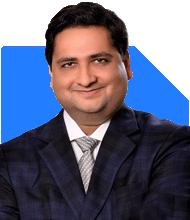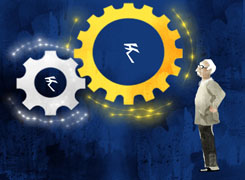Ramalingam Kalirajan |10924 Answers |Ask -Follow
Mutual Funds, Financial Planning Expert - Answered on May 19, 2024
He has an MBA in finance from the University of Madras and is a certified financial planner.
He is the director and chief financial planner at Holistic Investment, a Chennai-based firm that offers financial planning and wealth management advice.... more

Hi sir,my name is babu ,my age is 33 years. Please review my mutual fund portflio and i am keeping mf portflio for 15 years for retirement corpus. Lumpsum: 1.quant flexi cap fund-1 lakh 2.parag parikh flexi cap fund- 1.2 lakh 3.icici prudential equity and debt fund-50 k 4.quant large and midcap fund-1lakh 5.icici prudential blue chip- 1 lakh 6.edelweiss mid cap fund-1 lakh 7.icici prudential nifty next 50 index- 1lakh Sip: 1.motilal oswal nifty midcap 150 index-4500 2.motilal oswal nifty small cap 150 index-3500 3.HDFC S&P BSE 500 INDEX-2000 4.parag parikh flexi cap-2500 5.icici prudential blue chip-2000 6.hdfc nifty 50 index plan-2500 7.icici prudential nifty 50 index-3000 As i am keepimg mf's for my future goals,i want to take minimal risk. Please review my portfolio and suggest.
Firstly, congratulations on your thoughtful approach to building your mutual fund portfolio. You have a good mix of lump sum investments and SIPs, which is crucial for a well-rounded investment strategy.
Lump Sum Investments
Your lump sum investments are diversified across different categories, which is excellent for risk management. Let’s look at each fund:
Quant Flexi Cap Fund: This fund is versatile and can invest across market capitalizations.
Parag Parikh Flexi Cap Fund: Known for its value investing approach, it includes international stocks for additional diversification.
ICICI Prudential Equity and Debt Fund: This hybrid fund balances equity and debt, offering stability and growth.
Quant Large and Midcap Fund: Invests in large and mid-cap stocks, aiming for a balance of stability and growth.
ICICI Prudential Blue Chip Fund: Focuses on large-cap stocks, providing stability.
Edelweiss Mid Cap Fund: Targets mid-cap stocks, which have the potential for higher growth but come with higher risk.
ICICI Prudential Nifty Next 50 Index Fund: Tracks the Nifty Next 50 index, which can offer growth from emerging large-cap companies.
Systematic Investment Plans (SIPs)
Your SIPs also cover a range of index and active funds. Here’s an evaluation:
Motilal Oswal Nifty Midcap 150 Index Fund: Mid-cap index funds can be volatile but offer high growth potential.
Motilal Oswal Nifty Small Cap 150 Index Fund: Small-cap index funds have even higher growth potential with higher risk.
HDFC S&P BSE 500 Index Fund: A broad market index fund that offers comprehensive market exposure.
Parag Parikh Flexi Cap Fund: Continues to provide diversification and international exposure.
ICICI Prudential Blue Chip Fund: Consistent performer among large-cap funds.
HDFC Nifty 50 Index Plan: Tracks the Nifty 50 index, providing exposure to the top 50 companies.
ICICI Prudential Nifty 50 Index Fund: Another Nifty 50 tracker, providing redundancy in your portfolio.
Disadvantages of Index Funds
While index funds provide low-cost market exposure, they have some limitations compared to actively managed funds:
No Active Management: Index funds simply replicate the index and cannot react to market changes or economic shifts.
No Outperformance: They are designed to match the index performance, not exceed it. Actively managed funds aim to outperform the index.
Limited Flexibility: Index funds must follow the index composition, even if some stocks perform poorly.
Benefits of Actively Managed Funds
Actively managed funds, on the other hand, offer several benefits:
Professional Management: Fund managers make strategic decisions to outperform the market.
Dynamic Allocation: They can adjust the portfolio based on market conditions, potentially reducing risk.
Selective Investments: Fund managers can choose high-potential stocks, avoiding underperformers.
Recommendations
To minimize risk while aiming for growth, consider these adjustments:
Reduce Overlap in Index Funds: You have multiple funds tracking similar indices (Nifty 50). Consider reducing redundancy to simplify your portfolio.
Increase Allocation to Hybrid Funds: Hybrid funds offer a balanced approach, combining equity and debt for stability.
Focus on Quality Active Funds: Include more actively managed funds with a proven track record of consistent performance.
Conclusion
Your portfolio is well-diversified, but some adjustments can enhance its effectiveness. Reducing overlap and focusing more on active management can align with your goal of minimal risk and stable growth.
Best Regards,
K. Ramalingam, MBA, CFP,
Chief Financial Planner,
www.holisticinvestment.in
You may like to see similar questions and answers below
Nikunj Saraf | Answer |Ask -Follow
Mutual Funds Expert - Answered on Mar 18, 2023
Hardik Parikh | Answer |Ask -Follow
Tax, Mutual Fund Expert - Answered on Apr 20, 2023
Ramalingam Kalirajan |10924 Answers |Ask -Follow
Mutual Funds, Financial Planning Expert - Answered on May 19, 2024
Ramalingam Kalirajan |10924 Answers |Ask -Follow
Mutual Funds, Financial Planning Expert - Answered on May 27, 2024
Purshotam Lal |69 Answers |Ask -Follow
Financial Planner, MF and Insurance Expert - Answered on Dec 23, 2025
Samraat Jadhav |2522 Answers |Ask -Follow
Stock Market Expert - Answered on Dec 23, 2025
Samraat Jadhav |2522 Answers |Ask -Follow
Stock Market Expert - Answered on Dec 23, 2025
Samraat Jadhav |2522 Answers |Ask -Follow
Stock Market Expert - Answered on Dec 23, 2025
Samraat Jadhav |2522 Answers |Ask -Follow
Stock Market Expert - Answered on Dec 23, 2025
Samraat Jadhav |2522 Answers |Ask -Follow
Stock Market Expert - Answered on Dec 23, 2025
Dr Nagarajan J S K |2578 Answers |Ask -Follow
NEET, Medical, Pharmacy Careers - Answered on Dec 23, 2025
Samraat Jadhav |2522 Answers |Ask -Follow
Stock Market Expert - Answered on Dec 23, 2025
Ramalingam Kalirajan |10924 Answers |Ask -Follow
Mutual Funds, Financial Planning Expert - Answered on Dec 23, 2025
Radheshyam Zanwar |6753 Answers |Ask -Follow
MHT-CET, IIT-JEE, NEET-UG Expert - Answered on Dec 23, 2025

Suggestion - (1) Better to take regular BPT admission (1st year) only in a recognized university. (2) Or choose a different safe course instead of risky lateral entry. (It is more recommended)
The final choice/decision will be yours.
Good luck.
Follow me if you receive this reply.
Radheshyam
Pl follow and like if you are satisfied with the reply.


























